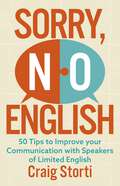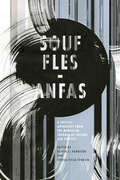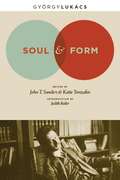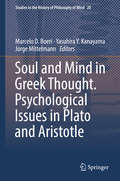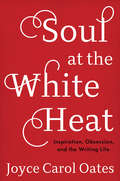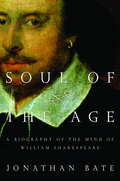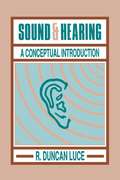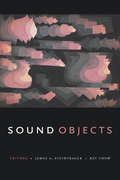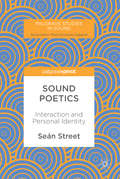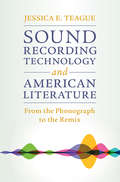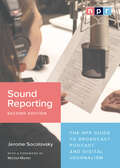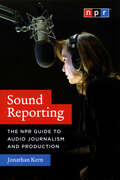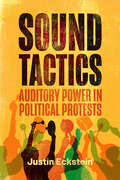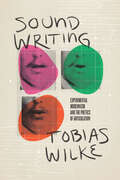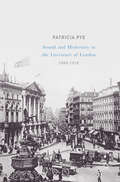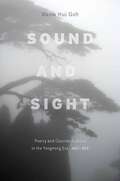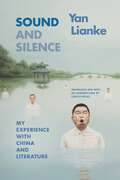- Table View
- List View
Sorry, No English: 50 Tips to Improve your Communication with Speakers of Limited English
by Craig StortiHave you ever struggled to communicate with a limited-English speaker? Have you been frustrated by unsuccessful interactions with non-native English speakers? Did you know there is a simple solution to improve cross-cultural communication in English?What most of us native speakers overlook in these situations is that the problem here may not be the limited English of the other person; it could be our English. And while we certainly can't do anything about the former, we can do a great deal about the latter.This short book gives 50 practical tools to help you become aware of and adapt your own language to completely transform exchanges with limited-English speakers and greatly increase the chances of a satisfying outcome for both you and the limited-English speaker you're trying to help or serve. And the good news is: it is not that difficult and it is entirely in the hands of the native speaker.Craig Storti is a nationally known figure with over 30 years of experience in the field of intercultural communications and cross-cultural adaptation, and the author of several standard works, including Culture Matters, a cross-cultural workbook used by the U. S. government in over 90 countries. He has successfully led workshops on cultural diversity for Fortune 500 companies, hotels such as Marriott, diplomats, civil servants, and foreign aid workers. But it was his 90-minute segments on common mistakes native speakers make when talking to limited-English speakers and how participants could improve interactions that became the most popular and useful aspect of his training. This much-needed book is ideal for anyone working in a public-facing job from government to hospitality, health care, international organizations, human resources, cross-cultural and diversity training, English as a second language teaching, foreign aid, or those with a love of language, culture and communication.
Souffles-Anfas
by Teresa Villa-Ignacio Olivia HarrisonSouffles-Anfas: A Critical Anthology from the Moroccan Journal of Culture and Politics introduces and makes available, for the first time in English, an incandescent corpus of experimental leftist writing from North Africa. Founded in 1966 by Abdellatif Laâbi and a small group of avant-garde Moroccan poets and artists and banned in 1972, Souffles-Anfas was one of the most influential literary, cultural, and political reviews to emerge in postcolonial North Africa. An early forum for tricontinental postcolonial thought and writing, the journal published texts ranging from experimental poems, literary manifestos, and abstract art to political tracts, open letters, and interviews by contributors from the Maghreb, the Middle East, Africa, Europe, and the Americas. The essays, poems, and artwork included in this anthology--by the likes of Abdelkebir Khatibi, Tahar Ben Jelloun, Albert Memmi, Etel Adnan, Sembene Ousmane, René Depestre, and Mohamed Melehi--offer a unique window into the political and artistic imaginaries of writers and intellectuals from the Global South, and resonate with particular acuity in the wake of the Arab Spring. A critical introduction and section headnotes make this collection the perfect companion for courses in postcolonial theory, world literature, and poetry in translation.
Soul Talk, Song Language: Conversations with Joy Harjo
by Joy Harjo Laura Coltelli Tanaya WinderIntimate and illuminating conversations with one of America's foremost Native artists Joy Harjo is a "poet-healer-philosopher-saxophonist," and one of the most powerful Native American voices of her generation. She has spent the past two decades exploring her place in poetry, music, dance/performance, and art. Soul Talk, Song Language gathers together in one complete collection many of these explorations and conversations. Through an eclectic assortment of media, including personal essays, interviews, and newspaper columns, Harjo reflects upon the nuances and development of her art, the importance of her origins, and the arduous reconstructions of the tribal past, as well as the dramatic confrontation between Native American and Anglo civilizations. Harjo takes us on a journey into her identity as a woman and an artist, poised between poetry and music, encompassing tribal heritage and reassessments and comparisons with the American cultural patrimony. She presents herself in an exquisitely literary context that is rooted in ritual and ceremony and veers over the edge where language becomes music.
Soul and Form (Columbia Themes in Philosophy, Social Criticism, and the Arts)
by Georg LukácsGyörgy Lukacs was a Hungarian Marxist philosopher, writer, and literary critic who shaped mainstream European Communist thought. Soul and Form was his first book, published in 1910, and it established his reputation, treating questions of linguistic expressivity and literary style in the works of Plato, Kierkegaard, Novalis, Sterne, and others. By isolating the formal techniques these thinkers developed, Lukács laid the groundwork for his later work in Marxist aesthetics, a field that introduced the historical and political implications of text.For this centennial edition, John T. Sanders and Katie Terezakis add a dialogue entitled "On Poverty of Spirit," which Lukács wrote at the time of Soul and Form, and an introduction by Judith Butler, which compares Lukács's key claims to his later work and subsequent movements in literary theory and criticism. In an afterword, Terezakis continues to trace the Lukácsian system within his writing and other fields. These essays explore problems of alienation and isolation and the curative quality of aesthetic form, which communicates both individuality and a shared human condition. They investigate the elements that give rise to form, the history that form implies, and the historicity that form embodies. Taken together, they showcase the breakdown, in modern times, of an objective aesthetics, and the rise of a new art born from lived experience.
Soul and Mind in Greek Thought. Psychological Issues in Plato and Aristotle (Studies in the History of Philosophy of Mind #20)
by Marcelo D. Boeri Yasuhira Y. Kanayama Jorge MittelmannThis book offers new insights into the workings of the human soul and the philosophical conception of the mind in Ancient Greece. It collects essays that deal with different but interconnected aspects of that unified picture of our mental life shared by all Ancient philosophers who thought of the soul as an immaterial substance. The papers present theoretical discussions on moral and psychological issues ranging from Socrates to Aristotle, and beyond, in connection with modern psychology. Coverage includes moral learning and the fruitfulness of punishment, human motivation, emotions as psychic phenomena, and more. Some of these topics directly stemmed from the Socratic dialectical experience and its tragic outcome, whereas others found their way through a complex history of refinements, disputes, and internal critique. The contributors present the gradual unfolding of these central themes through a close inspection of the relevant Ancient texts. They deliver a wide-ranging survey of some central and mutually related topics. In the process, readers will learn new approaches to Platonic and Aristotelian psychology and action theory. This book will appeal to graduate students and researchers in Ancient philosophy. Any scholar with a general interest in the history of ideas will also find it a valuable resource.
Soul at the White Heat: Inspiration, Obsession, and the Writing Life
by Joyce Carol OatesA new collection of critical and personal essays on writing, obsession, and inspiration from National Book Award-winning and New York Times bestselling author Joyce Carol Oates."Why do we write?"With this question, Joyce Carol Oates begins an imaginative exploration of the writing life, and all its attendant anxieties, joys, and futilities, in this collection of seminal essays and criticism. Leading her quest is a desire to understand the source of the writer's inspiration--do subjects haunt those that might bring them back to life until the writer submits? Or does something "happen" to us, a sudden ignition of a burning flame? Can the appearance of a muse-like Other bring about a writer's best work?In Soul at the White Heat, Oates deploys her keenest critical faculties, conjuring contemporary and past voices whose work she deftly and creatively dissects for clues to these elusive questions. Virginia Woolf, John Updike, Emily Dickinson, Henry James, J. M. Coetzee, Margaret Atwood, Joan Didion, Zadie Smith, and many others appear as predecessors and peers--material through which Oates sifts in acting as literary detective, philosopher, and student. The book is at its most thrilling when watching the writer herself at work, and Oates provides rare insight into her own process, in candid, self-aware dispatches from the author's own writing room. The New York Times Book Review has raved, "who better than Joyce Carol Oates . . . to explicate the craft of writing?" Longtime admirers of Joyce Carol Oates's novels as well as her prose will discover much to be inspired by and obsess upon themselves in this inventive collection from an American master.
Soul of the Age
by Jonathan Bate"Soul of the Age" is the most artful, intriguing, and satisfying study of the mind of William Shakespeare we now possess . . . A major achievement from a master of Shakespeare studies--David Armitage, professor of history, Harvard University.
Sound & Hearing: A Conceptual Introduction
by R. Duncan LuceThe major aim of this book is to introduce the ways in which scientists approach and think about a phenomenon -- hearing -- that intersects three quite different disciplines: the physics of sound sources and the propagation of sound through air and other materials, the anatomy and physiology of the transformation of the physical sound into neural activity in the brain, and the psychology of the perception we call hearing. Physics, biology, and psychology each play a role in understanding how and what we hear. The text evolved over the past decade in an attempt to convey something about scientific thinking, as evidenced in the domain of sounds and their perception, to students whose primary focus is not science. It does so using a minimum of mathematics (high school functions such as linear, logarithmic, sine, and power) without compromising scientific integrity. A significant enrichment is the availability of a compact disc (CD) containing over 20 examples of acoustic demonstrations referred to in the book. These demonstrations, which range from echo effects and filtered noise to categorical speech perception and total more than 45 minutes, are invaluable resources for making the text come alive.
Sound Linkage: An Integrated Programme for Overcoming Reading Difficulties
by Charles Hulme Fiona J. Duff Peter J. HatcherThe updated edition of this successful resource has been developed to support children with reading delays and dyslexia. It contains a phonological training programme, an explanation of how this programme can be embedded within a broader reading intervention, a standardized test of phonological awareness and a methodology to grade children’s reading books. This third edition has been revised throughout to include the latest developments in the field These resources have been used with a wide range of children and found to be suitable for use with any reading-delayed children, irrespective of cognitive ability and age All activities are accompanied by a set of photocopiable record sheets, a set of pictures, and an appendix of additional activities useful in helping children master a particular skill or to reinforce existing learning The ten sections of activities within the guide include: identification of words and syllables; identification and supply of rhyming words; identification and discrimination of phonemes; and blending, segmentation, deletion, substitution and transposition of phonemes within words.
Sound Objects
by Rey Chow James A. SteintragerIs a sound an object, an experience, an event, or a relation? What exactly does the emerging discipline of sound studies study? Sound Objects pursues these questions while exploring how history, culture, and mediation entwine with sound’s elusive objectivity. Examining the genealogy and evolution of the concept of the sound object, the commodification of sound, acousmatic listening, nonhuman sounds, and sound and memory, the contributors not only probe conceptual issues that lie in the forefront of contemporary sonic discussions but also underscore auditory experience as fundamental to sound as a critical enterprise. In so doing, they offer exciting considerations of sound within and beyond its role in meaning, communication, and information and an illuminatingly original theoretical overview of the field of sound studies itself. Contributors. Georgina Born, Michael Bull, Michel Chion, Rey Chow, John Dack, Veit Erlmann, Brian Kane, Jairo Moreno, John Mowitt, Pooja Rangan, Gavin Steingo, James A. Steintrager, Jonathan Sterne, David Toop
Sound Poetics
by Seán StreetThis book examines sonic signals as something both heard internally and externally, through imagination, memory and direct response. In doing so it explores how the mind 'makes' sound through experience, as it interprets codes on the written page, and creates an internal leitmotif that then interacts with new sounds made through an aural partnership with the external world, chosen and involuntary exposure to music and sound messages, both friendly and antagonistic to the identity of the self. It creates an argument for sound as an underlying force that links us to the world we inhabit, an essential part of being in the same primal sense as the calls of birds and other inhabitants of a shared earth. Street argues that sound as a poetic force is part of who we are, linked to our visualisation and sense of the world, as idea and presence within us. This incredibly interdisciplinary book will be of great interest to scholars of radio, sound, media and literature as well as philosophy and psychology.
Sound Recording Technology and American Literature: From the Phonograph to the Remix (Cambridge Studies in American Literature and Culture #187)
by Jessica E. TeaguePhonographs, tapes, stereo LPs, digital remix - how did these remarkable technologies impact American writing? This book explores how twentieth-century writers shaped the ways we listen in our multimedia present. Uncovering a rich new archive of materials, this book offers a resonant reading of how writers across several genres, such as John Dos Passos, Langston Hughes, William S. Burroughs, and others, navigated the intermedial spaces between texts and recordings. Numerous scholars have taken up remix - a term co-opted from DJs and sound engineers - as the defining aesthetic of twenty-first century art and literature. Others have examined modernism's debt to the phonograph. But in the gap between these moments, one finds that the reciprocal relationship between the literary arts and sonic technologies continued to evolve over the twentieth century. A mix of American literary history, sound studies, and media archaeology, this interdisciplinary study will appeal to scholars, students, and audiophiles.
Sound Reporting
by Jonathan KernPerhaps you've always wondered how public radio gets that smooth, well-crafted sound. Maybe you're thinking about starting a podcast, and want some tips from the pros. Or maybe storytelling has always been a passion of yours, and you want to learn to do it more effectively. Whatever the case--whether you're an avid NPR listener or you aspire to create your own audio, or both--Sound Reporting: The NPR Guide to Audio Journalism and Production will give you a rare tour of the world of a professional broadcaster. Jonathan Kern, who has trained NPR's on-air staff for years, is a gifted guide, able to narrate a day in the life of a host and lay out the nuts and bolts of production with equal wit and warmth. Along the way, he explains the importance of writing the way you speak, reveals how NPR books guests ranging from world leaders to neighborhood newsmakers, and gives sage advice on everything from proposing stories to editors to maintaining balance and objectivity. Best of all--because NPR wouldn't be NPR without its array of distinctive voices--lively examples from popular shows and colorful anecdotes from favorite personalities animate each chapter. As public radio's audience of millions can attest, NPR's unique guiding principles and technical expertise combine to connect with listeners like no other medium can. With today's technologies allowing more people to turn their home computers into broadcast studios, Sound Reporting couldn't have arrived at a better moment to reveal the secrets behind the story of NPR's success.
Sound Reporting, Second Edition: The NPR Guide to Broadcast, Podcast and Digital Journalism
by Jerome SocolovskyAn indispensable guide to audio journalism grounded in NPR’s journalistic values and practices, with tips and insights from its top reporters, hosts, editors, producers, and more. A lot has changed in media in recent years, but one thing that remains steadfast is National Public Radio’s (NPR) position as a trusted source of news in the United States. Now producing dozens of shows and podcasts, plus livestreams and coverage on other media platforms, NPR is the leading authority on reporting, writing, and delivering audio news and storytelling to today's diverse audiences. In this completely revised guide, audio journalism trainer Jerome Socolovsky offers a look into just how NPR does it, following the same journey a story would from idea to the moment it reaches its listeners. Based on more than eighty interviews with producers, reporters, editors, hosts, and other NPR staffers, Sound Reporting reveals how stories get pitched; how they are reported, produced, written, edited, voiced, and tailored to multiple media formats; and how shows and podcasts are put together. It begins with a presentation of NPR's values and includes a new chapter on journalist safety, a topic of timely importance. Podcasts, now part of the mainstream of the media universe, are treated alongside traditional programs throughout. In these pages, the voices of NPR staff offer a glimpse into their profession. Discover how correspondent Ruth Sherlock overcame seemingly insurmountable odds as she raced to the scene of a devastating earthquake in Turkey, the four main ways Ramtin Arablouei incorporates music into podcasts, and how “Weekend Edition” host Ayesha Rascoe touches listeners so deeply she received a pair of homemade potholders in the mail from one of them. Reading this book is like sitting in a room full of top-notch producers, seasoned correspondents, trusted hosts, and rigorous editors—all telling you inspiring stories about their craft to help you learn from their experience. At a time when the legitimacy and authority of journalism are under critique, transparency into how the news is made is more important than ever. This book offers a fascinating look behind the scenes at a premier public media organization and will be a trusted resource for anyone in or exploring a future in audio journalism.
Sound Reporting: The NPR Guide to Audio Journalism and Production
by Jonathan KernPerhaps you’ve always wondered how public radio gets that smooth, well-crafted sound. Maybe you’re thinking about starting a podcast, and want some tips from the pros. Or maybe storytelling has always been a passion of yours, and you want to learn to do it more effectively. Whatever the case—whether you’re an avid NPR listener or you aspire to create your own audio, or both—Sound Reporting: The NPR Guide to Audio Journalism and Production will give you a rare tour of the world of a professional broadcaster. <p><p> Jonathan Kern, who has trained NPR’s on-air staff for years, is a gifted guide, able to narrate a day in the life of a host and lay out the nuts and bolts of production with equal wit and warmth. Along the way, he explains the importance of writing the way you speak, reveals how NPR books guests ranging from world leaders to neighborhood newsmakers, and gives sage advice on everything from proposing stories to editors to maintaining balance and objectivity. Best of all—because NPR wouldn’t be NPR without its array of distinctive voices—lively examples from popular shows and colorful anecdotes from favorite personalities animate each chapter. <p> As public radio’s audience of millions can attest, NPR’s unique guiding principles and technical expertise combine to connect with listeners like no other medium can. With today’s technologies allowing more people to turn their home computers into broadcast studios, Sound Reporting couldn’t have arrived at a better moment to reveal the secrets behind the story of NPR’s success.
Sound Tactics: Auditory Power in Political Protests (RSA Series in Transdisciplinary Rhetoric)
by Justin EcksteinFrom call and response chants to the noise of pots and pans, protests are often defined by their sounds. In this book, Justin Eckstein argues that this is not merely the result of catchy slogans; it is due to sound’s ability to hold those in power accountable. Sound Tactics highlights how, in a world grappling with the uncertainty of emergent digital practices, social movements utilize the rhetorical power of sound.Eckstein uses the waveform as a metaphor for the persuasive potential of sound. Examining the case studies of the March for Our Lives protest, Howard University’s HUResist movement, and the Casseroles protest in Montreal, Eckstein demonstrates how changes to the immediacy, intensity, and immersiveness of sound can affect the power of an argument. The collective use of sound in these case studies conveys the unity of the protestors in their demand for change and underlines the strength of their argument to those in power.More than just the written word spoken aloud, sound has unique layers of added meaning—it can convey length of time, demand attention, and signal disapproval. Eckstein’s study unpacks those layers for scholars and students, as well as activists interested in deploying sound for change.
Sound Writing: Experimental Modernism and the Poetics of Articulation
by Tobias WilkeConsiders the avant-garde rethinking of poetic language in terms of physical speech production. Avant-garde writers and artists of the twentieth century radically reconceived poetic language, appropriating scientific theories and techniques as they turned their attention to the physical process of spoken language. This modernist “sound writing” focused on the bodily production of speech, which it rendered in poetic, legible, graphic form. Modernist sound writing aims to capture the acoustic phenomenon of vocal articulation by graphic means. Tobias Wilke considers sound writing from its inception in nineteenth-century disciplines like physiology and experimental phonetics, following its role in the aesthetic practices of the interwar avant-garde and through to its reemergence in the postwar period. These projects work with the possibility of crossing over from the audible to the visible, from speech to notation, from body to trace. Employing various techniques and concepts, this search for new possibilities played a central role in the transformation of poetry into a site of radical linguistic experimentation. Considering the works of writers and artists—including Raoul Hausmann, Kurt Schwitters, Viktor Shklovsky, Hugo Ball, Charles Olson, and Marshall McLuhan—Wilke offers a fresh look at the history of the twentieth-century avant-garde.
Sound and Meaning in East Cushitic Languages: Dhaasanac, Burji, Rendille, Somali, and Afar (SpringerBriefs in Linguistics)
by Sumiyo NishiguchiThis book, one of the few English language publications on indigenous languages spoken in East Africa, highlights theoretical contributions on understudied East Cushitic languages, based on extensive data. It introduces readers to important fields such as the OT phonology and morphology of Dhaasanac and discusses the syntax of negation, semantics of focus, negation and context shift. It then examines negative polarity items and context sensitivity in the Rendille, Burji, Somali and Afar languages to offer broader insights into these phenomena. Given its focus, the book will appeal to researchers and students who are interested in formal semantics, pragmatics and indigenous studies around the globe, especially those wanting to learn about East Cushitic linguistics.
Sound and Modernity in the Literature of London, 1880-1918
by Patricia PyeThis book explores the literary representation of late Victorian and early Edwardian London from an auditory perspective, arguing that readers should 'listen' to impressions of the city, as described by writers such as Conrad, Doyle, Ford and Gissing. It was in this period that London began to 'sound modern' and, through a closer hearing of its literature, writers' wider responses to modernity are revealed. The book is structured into familiar modernist themes, revisiting time and space, social progress and popular culture through an exploration of the sound impressions of some key works. Each chapter is contextualized by these themes, revealing how the sound of the news, social protest, music hall and suburbanization impacted on writers' literary imaginations. Suitable for students of modernist literature and specialists in sound studies, this book will also appeal to readers with a wider interest in London's history and popular culture between 1880-1918.
Sound and Sight: Poetry and Courtier Culture in the Yongming Era (483-493)
by Meow GohThis is the first book to examine Chinese poetry and courtier culture using the concept of shengse—sound and sight—which connotes "sensual pleasure." Under the moral and political imperative to avoid or even eliminate representations of sense perception, premodern Chinese commentators treated overt displays of artistry with great suspicion, and their influence is still alive in modern and contemporary constructions of literary and cultural history. The Yongming poets, who openly extolled "sound and rhymes," have been deemed the main instigators of a poetic trend toward the sensual. Situating them within the court milieu of their day, Meow Hui Goh asks a simple question: What did shengse mean to the Yongming poets? By unraveling the aural and visual experiences encapsulated in their poems, she argues that their pursuit of "sound and sight" reveals a complex confluence of Buddhist influence, Confucian value, and new sociopolitical conditions. Her study challenges the old perception of the Yongming poets and the common practice of reading classical Chinese poems for semantic meaning only.
Sound and Silence: My Experience with China and Literature (Sinotheory)
by Lianke YanYan Lianke is a world-renowned author of novels, short stories, and essays whose provocative and nuanced writing explores the reality of everyday life in contemporary China. In Sound and Silence, Yan compares his literary project to a blind man carrying a flashlight whose role is to help others perceive the darkness that surrounds them. Often described as China’s most censored author, Yan reflects candidly on literary censorship in contemporary China. He outlines the Chinese state’s project of national amnesia that suppresses memories of past crises and social traumas. Although being banned in China is often a selling point in foreign markets, Yan argues that there is no requisite correlation between censorship and literary quality. Among other topics, Yan also examines the impact of American literature on Chinese literature in the 1980s and 1990s. Encapsulating his perspectives on life, writing, and literary history, Sound and Silence includes an introduction by translator Carlos Rojas and an afterword by Yan.
Sound it Out!: Phonics in a Comprehensive Reading Program (Fourth Edition)
by John F. SavageThis book covers both the content of phonics and the ways in which it can be effectively integrated into a comprehensive classroom reading program. The text contains practical teaching suggestions for phonemic awareness, phonics, and spelling. The fourth edition features an increased emphasis on technology as it applies to phonics instruction, along with additional focus placed on helping children who have trouble learning acquire basic phonics skills.
Sound, Sense, and Rhythm: Listening to Greek and Latin Poetry (Martin Classical Lectures #16)
by Mark W. EdwardsThis book concerns the way we read--or rather, imagine we are listening to--ancient Greek and Latin poetry. Through clear and penetrating analysis Mark Edwards shows how an understanding of the effects of word order and meter is vital for appreciating the meaning of classical poetry, composed for listening audiences. The first of four chapters examines Homer's emphasis of certain words by their positioning; a passage from the Iliad is analyzed, and a poem of Tennyson illustrates English parallels. The second considers Homer's techniques of disguising the break in the narrative when changing a scene's location or characters, to maintain his audience's attention. In the third we learn, partly through an English translation matching the rhythm, how Aeschylus chose and adapted meters to arouse listeners' emotions. The final chapter examines how Latin poets, particularly Propertius, infused their language with ambiguities and multiple meanings. An appendix examines the use of classical meters by twentieth-century American and English poets. Based on the author's Martin Classical Lectures at Oberlin College in 1998, this book will enrich the appreciation of classicists and their students for the immense possibilities of the languages they read, translate, and teach. Since the Greek and Latin quotations are translated into English, it will also be welcomed by non-classicists as an aid to understanding the enormous influence of ancient Greek and Latin poetry on modern Western literature.
Sound, Space and Civility in the British World, 1700-1850 (British Literature in Context in the Long Eighteenth Century)
by Bruce Buchan Peter Denney David Ellison Karen CrawleyIn this collection, the essays examine the critical role that judgments about noise and sound played in framing the meaning of civility in British discourse and literature during the long eighteenth century. The volume restores the sonic dimension to conversations about civil conduct by exploring how censured behaviours and recommended practices resonated beyond the written word. As the contributors show, understanding changing perceptions and valuations of noise and sound allows us to chart how civility was understood in the context of significant political, social and cultural change, including the development of urban life, the extension of empire and the consolidation of legal procedure. Divided into three parts, Sound, Space and Civility in the British World demonstrates how both noise and sound could be recognized by eighteenth-century Britons as expressions of civility. The essays also explore the audible implications of uncivil conduct to complicate our understanding of the sonic range of politeness. The uses of sound and noise to interrogate British colonial anxieties about the distinction between civility and incivility are also investigated. Taken together, the essays identify the emergence of civility as a development that radically altered sonic attitudes and experiences, producing new notions of what counted as desirable or undesirable sound.
Sound/Spelling Cards, Grade 1 and Grade 2 (Into Reading)
by Houghton Mifflin Harcourt Publishing CompanyNIMAC-sourced textbook
